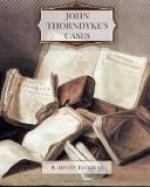He handed to Thorndyke a bundle of ruled sheets, which my colleague examined attentively for a while, and then passed on to me.
“This is very systematic and thorough,” said he. “But now let us see the final result at which he arrives.”
“It may be all very systematic,” growled the superintendent, sorting out his papers, “but I tell you, sir, it’s all BOSH!” The latter word he jerked out viciously, as he slapped down on the table the final product of the Professor’s labours. “There,” he continued, “that’s what he calls the ‘full rendering,’ and I reckon it’ll make your hair curl. It might be a message from Bedlam.”
Thorndyke took up the first sheet, and as he compared the constructed renderings with the literal translation, the ghost of a smile stole across his usually immovable countenance.
“The meaning is certainly a little obscure,” he observed, “though the reconstruction is highly ingenious; and, moreover, I think the Professor is probably right. That is to say, the words which he has supplied are probably the omitted parts of the passages from which the words of the cryptogram were taken. What do you think, Jervis?”
[Illustration: THE PROFESSOR’S ANALYSIS.
Handwritten: Analysis of the cipher with translation into modern square Hebrew characters + a translation into English. N.B. The cipher reads from right to left.]
He handed me the two papers, of which one gave the actual words of the cryptogram, and the other a suggested reconstruction, with omitted words supplied. The first read:
“Woe city lies robbery prey noise whip rattling wheel horse chariot day darkness gloominess cloud darkness morning mountain people strong fire them flame.”
Turning to the second paper, I read out the suggested rendering:
“’Woe to the bloody city! It is full of lies and robbery; the prey departeth not. The noise of a whip, and the noise of the rattling of the wheel_s_, and of the prancing horse_s_, and of the jumping chariot_s_.




